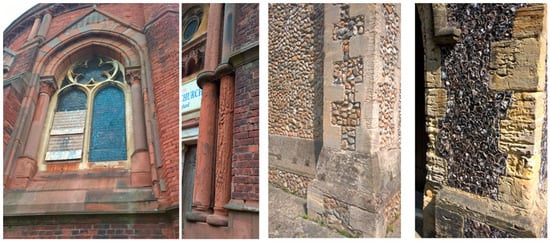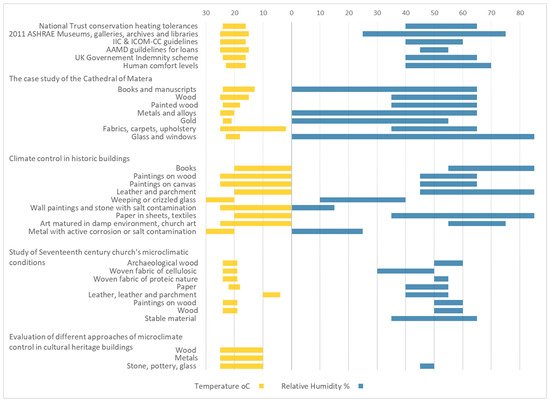You're using an outdated browser. Please upgrade to a modern browser for the best experience.
Please note this is a comparison between Version 1 by Robin Talbot and Version 2 by Conner Chen.
Historic churches are a class of building which embody significant cultural heritage; as a result, they are historically listed in recognition of the contribution they make to the built environment Simple on/off space heating systems are installed in many churches to increase human comfort. However, the conservation of the important historic artefacts and artwork contained within may not have been fully considered.
- heating
- conservation
- church
1. Introduction
Historic churches are a class of building which embody significant cultural heritage; as a result, they are historically listed in recognition of the contribution they make to the built environment [1]. Frequently composed of different building materials and techniques, these have been adapted over hundreds of years to fit stylistic changes alongside congregational and maintenance requirements. Churches are often home to important artefacts and design features that require consideration in terms of conservation, yet historic churches seldom possess heating and ventilation systems (HVAC) which effectively monitor and control temperature and humidity to preserve artefacts’ life and condition.
Where space heating is used in historic churches, it often focuses on human thermal comfort rather than the building and artefact requirements, inducing large fluctuations in temperature and relative humidity [2]. Space heating systems attempt to condition large volumes of air in the church in an often futile effort to meet modern comfort expectations [3]. Despite construction utilising high thermal mass materials, the sporadic nature of church services results in an environment which is often below human comfort levels [4]. The repeated heating of such high thermal mass buildings often introduces degrading processes in high value artefacts such as paintings, fabric, artwork and musical instruments like the organ [5].
In order to protect and preserve historic buildings for the future, major alterations to their fabric and character are usually prohibited. Historic buildings such as churches have been exempted from energy efficiency targets because they are constructed using methods which do not meet energy performance benchmarks [6]. In addition, undertaking any retrofitting of energy saving measures may result in damage to the historic fabric and artefacts contained within [7][8][7,8]. Historic building fabric is porous, requiring a careful management of ventilation to prevent excessive moisture accumulating in the fabric and internal space [9][10][9,10]. British Standard EN 15759-1: Heating churches, chapels and other places of worship suggests that the ideal solution is to maintain suitable environmental conditions over a constant period, although it does not specify temperature and relative humidity ranges, rather focusing on the type of systems available and their general effect upon the conservation of the building and its contents [11].
One heating option discussed in EN 15759-1 is conservation heating. This is a strategy some historic properties implement to focus on the preservation of fabric and artefacts through controlling relative humidity. The control of moisture condensation and frost is deemed more important in conservation than human comfort levels [11]. Conservation heating aims to meet the standard for environmental control set out by the National Trust but results in a wide range of room temperatures [12]. The operation of heating solely to preserve church artefacts risks degrading human comfort and limiting the use of the space at a time when churches are looking to utilise buildings for the wider community [13]. If churches are to be heated regularly in response to increased usage patterns, research is required to understand if the internal environment of historic churches is suitable to meet the needs of conservation, while attempting to meet human comfort demands.
Guidelines and standards exist for museums and art galleries to maintain good conservation standards through the operation of HVAC systems. The British Standards Institution BS EN 15759-1:2011 [11] establishes that relative humidity (RH) is generally the most critical parameter from a conservation point of view, and shall therefore be kept at a defined level and as stable as possible. While not every museum and art gallery have sophisticated HVAC and/or building management control systems installed, they are, at an institutional level, focused on best practice in managing conservation and maintaining collections in good order. Therefore, the option to consider if the specific temperature and relative humidity ranges outlined in the standards applicable to the museum and conservation sector are relevant when historic churches look towards the increased operation of less sophisticated retrofitted HVAC systems to meet increased usage patterns.
2. Building Fabric
Historic churches are monuments to traditional building practices and skills. Often composed of different materials, building techniques and styles, many church buildings have been in regular use for hundreds of years. Alterations and repairs have taken place during the lifetime of the building in response to changing needs and the degradation of fabric components. Hoping to remedy the problems inherent to the traditional construction, modern building technologies and materials have been applied to traditional buildings, resulting in new and more complex problems. In many cases, a lack of knowledge related to the function of traditional buildings and their materials has played a part in creating problems for building operators [14]. In some cases, these individual interventions do not appear to singularly cause a problem, but in combination, they are damaging to the building [15][16][15,16]. It should be recognised that historic buildings possess more complex interactive bioclimatic properties when compared to modern equivalents [7]. Christian church design and layout generally conform to the established parameters inherent to the faith. The majority of Christian churches were built with the nave oriented west to east, typically having the main entrance at the west end of the church. Site restrictions and peculiarities result in some churches which do not conform to these design principles [17]. Cathedrals also adhere to the same principles of orientation, but with somewhat grander designs: walls are thick masonry with deep window and door reveals. The availability of quality building materials on a local level has resulted in varying construction techniques across Europe. Flint construction and infill feature heavily in Dorset, Wiltshire, Hampshire, Sussex, Kent, Surrey, Berkshire, Suffolk and Norfolk (UK) and have been used in many of those region’s churches [18]. Examples of typical construction materials can be seen in Figure 1.
Figure 1. Brick and sandstone construction exhibiting weathering (left) and two examples of masonry wall with flint construction (right). Photographs R. Talbot.
Table 1.
Wall thickness of six historic European religious buildings—sourced from listed authors.
| Country | Church | Constructed | Material | Wall Thickness | Ref. |
|---|---|---|---|---|---|
| Sweden | Hamrånge | 1850 | Stone | 1.3 m | [24] |
| Denmark | Gundsømagle | 12th Century | Calcareous tufa (Limestone) | 0.8 m | [25] |
| Italy | The Matera Cathedral | 1270 | Sandstone calcarenite (Limestone) | 0.8 m | [26] |
| Italy | Basilica di Collemaggio | 14th Century | Limestone | 1–2.6 m | [2] |
| Italy | Chiesa di San Francesco | 14th Century | Limestone | 0.8 m | [23] |
| Portugal | Monastery of Jeronimos | 16th Century | Limestone | 1.9–2.65 m | [27] |
| Portugal | Bernardas’ Convent | 18th Century reconstruction | Limestone | 1 m | [28] |
| Romania | Saint Michael Archangel | 1894 | Sand limestone | 0.8 m | [29] |
3. Artefacts
Historic churches represent a rich legacy of liturgical development covering hundreds of years. With changing fashions, the interior decoration of the buildings and the artefacts were adjusted or obscured. In some cases, church ownership passed to different denominations with their own stylistic view point. In addition to the usual artefacts present within UK churches, there are some remarkable survivors, despite the changing views on religious art and decoration, representing rare examples of Christian artwork [30][31][30,31]. To maintain conservation standards, the selection of the guidelines reviewed here set out the tolerance to fluctuating relative humidity. By setting limits on changes to the RH in a 24 h period, damage to artefacts can be avoided, especially those which undergo mechanical changes, such as wood. Laboratory tests on wood samples have shown that wood takes one day or more to adapt to new environmental conditions [32]. Schito et al. [33] attributed deterioration of a painting on the Scrovegni Chapel walls and wooden objects in the Roslyn Chapel to high values of relative humidity. Therefore, the duration of the fluctuation is important in the preservation of wooden artefacts. The high moisture content in wood also has the potential to foster development of rot fungi and wood borers [34]. The desire to control relative humidity and the resulting damage to artefacts and building fabrics prompted the concept and application of conservation heating in National Trust properties. Historic properties normally experience relative humidity levels between 60–80% [35], which is above the maximum that many artefacts can tolerate for long periods without experiencing degradation. Over time, the tolerance and range has been adjusted due to the financial implications of providing heating to larger properties and a greater understanding of the behaviour of artefacts with the duration and range of fluctuations in relative humidity. Human comfort is considered secondary to control of relative humidity in National Trust properties; therefore, comfort boost heating has been established during visiting times to maintain an environment conducive to visitors and staff. The drawback of such humidistat controlled heating systems is the increased temperatures required in summer months to keep relative humidity within acceptable ranges. At a time when humidity is highest in the outdoor environment, and often coinciding with higher air temperatures, heating a property up to 30 °C to maintain 58% RH is difficult to justify. Therefore, the proposal to limit room temperature to 22 °C in summer and allow the RH to increase has been the National Trust policy since 1994. However, with climate change, the percentage of time that RH control is lost in a calendar year has increased [35]. Most historic churches were built without heating systems; therefore, artefacts may have resided within the natural indoor environment for many generations. With the advent and installation of space heating systems, the historic environment has been changed to one that favours human comfort. Legner and Geijer [36] highlighted the increasing frequency of the conservation required for wooden artefacts when space heating was installed in old Swedish churches. The most common damages reported were the cracking of paint and desiccation cracks. The desire to achieve human comfort may cause degradation of heritage items [2], although materials respond differently to changes in temperature and relative humidity. Items made of wood, for example, take longer to respond to changes than other artefact types. A comparison of the recommended temperatures and relative humidity ranges for artwork, displays and internal spaces are detailed in Figure 2. The data are sourced from four separate studies encompassing microclimate, thermal comfort, hygrometric and climate control research in historic buildings.
Figure 2. Sensitivity ranges for individual items and material types. The case study of the Cathedral of Matera [26], Climate control in historic buildings [37][38], Study of Seventeenth century church’s microclimatic conditions [38][37], Evaluation of different approaches of microclimate control in cultural heritage buildings [39].
